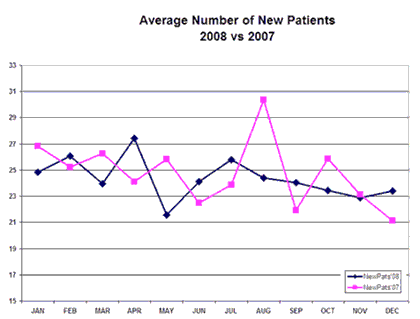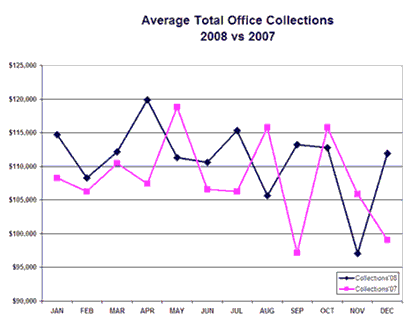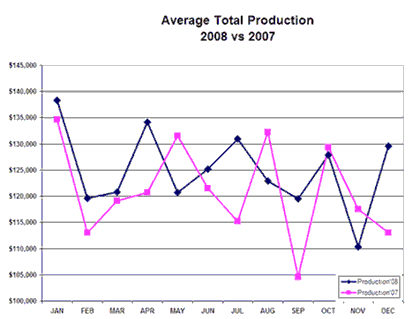Bulletin, February 2009
The Latest in Area Economic and Technical Trends
Exclusively to Clients and Friends of Advanced Practice Management
The 2008 Dental Dow Jones:
Our sample of mature area practices showed practice production was up 3.5% and collections were up 3.0% compared to the 2007 averages.
There was a slight increase in patient flow. Total Exams were up 1.5%. New patients were down slightly,-2.0%. Crown and bridge production was up 1.7%. Down time in the Doctor and Hygiene Schedules increased.
Overall, the statistics show that 2008 was a relatively stable year. There was certainly no economic surge but there was no Dental depression either.
There may be thunder clouds on the horizon but make hay when the sun shines! Our stats show that December, January and February are the most active crown and bridge months of the year.
Although the economy may very well affect your patients’ choices, it should not affect your diagnoses. The economy is a factor but there still is much you can do to insure practice security and prosperity. Read on!
Office overhead:
The accounting firm of Davich, Wilson and Morrow and Associates, PA recently completed their bi-annual Overhead Survey. It’s the best of its kind for our area. Here are some of the findings:
- Average practice overhead as a percentage of collections is about 64%.
- Therefore, Net before taxes is 36% of collections.
- The average office spends 26.8% of its collections on Gross Staff Wages.
- If you also take into account staff benefits, medical and retirement plans, Staff Costs are about 31% of collections.
- In this survey the average practice collected $763,444 and the Doctor netted $275,000
Management by fear:
Almost anyone would agree that hard work, intelligence and integrity are important components of success… but there is another trait that is not talked about as often that is equally important: courage.
Just as you would predict that someone who was lazy, stupid and dishonest would not be successful…it is important to note that someone who is fearful would have limited success too. How does this manifest itself in a dental practice?
Situation #1: A practitioner in a small- to medium-sized town with seven to ten major employers gets a letter from a PPO announcing that it has captured the business of one of those employers. The letter implies that he should sign up (and accept the reduced fee schedule) or he’s liable to lose a significant portion of his patients.
The practitioner signs up with the PPO… not to explore an opportunity or gain a benefit, but out of fear of losing patients.
Situation #2: A dentist has a front desk person who has been with his practice ten years. She consistently rejects the dentist’s suggestions on how to improve the practice. She occasionally offends patients. Other staff have left because of her. Still, this person is the only one who really seems to know the computer and is very efficient. The dentist feels that his practice would go into chaos without her. So, despite her intransigent and disruptive behavior, he does not replace her out of fear that she is irreplaceable.
Situation #3: The dentist is very busy and cramped in her three operatory offices. She has room to add another operatory but the equipment and their related expenses in expanding the facility might cost her $60,000. Because of the uncertain nature of dentistry nowadays (increased competition, PPO care, etc.), she holds off doing it even though she is very busy. She fears she might over expand and be stuck with high overhead while facing an open schedule.
Situation #4: A Doctor in a small town is worried about increasing his extremely low fee schedule because the other Doctor in town also has a very low schedule. He is afraid that he would lose patients.
Situation #5: A Doctor does not take the time or money to attend an important continuing education event because she fears that the temporary loss of income will not be recovered. She is just making ends meet as it is.
Situation #6: A Doctor does not present his best options to a patient because he fears that the patient will say, “No.” The truth is this is dentistry he would have in his own mouth; however, he doesn’t think the patient will feel he can afford it. Previously, when patients have declined carefully proposed treatment he found it quite upsetting.
Situation #7: A Doctor wants to be more active in the delivery of perio treatment to her patients but she fears if she does, so many will ask, “Why haven’t you talked to me about this before?”
In all the situations above, the Doctor is making (or not making) a decision based on fear of loss instead of anticipating gain from exploring opportunities. The Doctor may be hardworking, intelligent and feel that he/she is being prudent by making the decision, but in actuality the decision was not the wisest or the most prudent. Fear is a most insidious enemy!
Still, when you are in the thick of things, it’s hard to remove yourself and know if you are being objective. In general though, playing it “safe” is probably more dangerous than doing what may, on the surface, look risky.
Now, I’m not recommending firing staff, adding to facilities, or even spurning PPOs willy nilly. But, if you find yourself often trying to overcome situations just through hard work, worry or fighting to maintain the status quo, then you know you would probably do better if you accepted a little more risk. After all, to go into private practice in the first place required courage! It is just that once you are in practice and established you can feel that you have more to lose than to gain. If every Doctor practiced with this same enthusiasm, optimism, and courage as they did the first day they opened their practice, the level of success achieved could be astonishing.
Let’s look at the flip side of some of the above situations: In Situation #1 the Doctor declines joining the PPO and accepting $4,000 or $6,000 per month in write-offs. Instead, he invests $2,000 per month in a marketing campaign and gains additional patients. As a result, he’s less dependent on PPOs and less vulnerable than his counterpart who signed up.
In Situation #2 the Doctor terminates the “irreplaceable” employee and after careful searching finds a replacement. She brings a new and refreshing perspective to the practice. The team respects the Doctor’s leadership in making a tough decision and it is affirmed that no one is indispensable. The Doctor is back in control of her practice!
In Situation #3 the Doctor goes ahead and invests the $60,000 on the expansion…financed over five years at 8%. The payment comes to about $1,216 per month. With that additional capacity, her practice grows to a new level and she attains prosperity she could never have by playing it safe. Before she expanded the room, however, she did an Active Patient Count, checked on her recall effectiveness to see if there was potential for expansion, and did a cost-benefit analysis. The analysis told her she would have to average one more patient treated per day as a result of that expansion to make it worthwhile, or fill five additional hygiene days per month (or a combination of the two). Framed that way, they knew they could do it and she’d make more money on that investment than anything in the stock market (by far!).
I’ve actually seen every situation I’ve described above. I could go on and on but, you get the point. If you really want things to go the way you want them to, you have got to create your future versus letting your future happen to you. You can’t just play defense.
A courageous approach also changes your staff meetings. Are you focusing on opportunities or problems in staff meetings? Problems with cancellations, patient credit problems, cranky patients, etc., will always be with you. Sure, you want to minimize them, but are you focusing on opportunities instead of going over and over the same problems? Keep focused on what you want, not what you don’t want.
You must also realize that there has always been something that somehow threatens the dental profession. That’s the way it is with every business! Again, go back to the first day you started practice. A successful small business person has to be optimistic and courageous. Otherwise, one might as well go hit the bottle or work at the factory until doomsday finally arrives. Plan on succeeding and you will.
Set those goals:
This is a critical process to your success.
Even if your goal is to “Hold the Fort” this year, you should put it in writing and have a plan to do so. However, if you are serious about growth, you can have it!
Our advice works. You will prosper to the degree that you and your staff follow it. We can’t predict the future, and we are not all-knowing, but we do know the business of Dentistry. Well managed practices weather adverse conditions better… much better.
Many of us have been around long enough to remember the 1981 recession. There was almost 10% unemployment and interest rates were 20%. The national recession didn’t seem to reach Minnesota’s dentists until 1983. The dentists that we worked with then (many of whom we are still working with) didn’t all have banner years but they weathered the storm pretty well.
Oldies but Goldies that will help you make or save money:
For many of you, staff performance reviews are coming up. It’s quite plausible that a lot of Dental practices won’t be automatically awarding raises this year.
In my opinion there should never be automatic raises awarded. Staff raises should be based on how the practice does and the performance of each team member. As I’ve said a million times before: Be generous with your staff, but If you give a raise, get something for it!
You can end up making money by giving raises. For example, a front desk person’s raise is linked to them occasionally working evening hours to reach patients they couldn’t reach during the day (for purposes of collection or recall calling). That extra $200 she earns per month is counteracted by $3,000 more per month in production from scheduling, say, six more patients than she would have otherwise. Or, for example, $1,200 more in collections for making 15 phone calls that wouldn’t have been made otherwise. Be generous with your praise—Get something for the raise!
Synchronize Your Vacations: If a hygienist takes a week off (while you’re working) and you do not arrange to maintain hygiene capacity, it can cost you about $8,000 in production and $3,000+ on your bottom line. In short, an unsynchronized hygiene vacation can cost you your vacation.
If you post your vacation days and Continuing Ed day times off well ahead of time then you can work with the staff to synch things up so everyone is happy.
Time Clock Management: A very common phenomenon in Dental offices, particularly in larger offices, is too many employees checking in too early or checking out too late…or not checking out if they have nothing to do. This is a good time to tighten up on the time clock.
Be able to produce readable management-friendly Income and Expense reports that you look at at least monthly. These must be organized so you can clearly see your bottom line and expenses are arranged so they are easily compared to Industry Standards. Plus, set up a budget. We can help you with this. Just ask.
We promise to keep you informed and work with your team to ensure your practice is safe and prosperous.
Sincerely,






